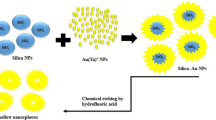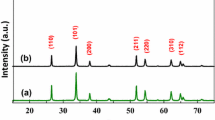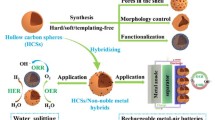Abstract
Although gold hollow spheres show unique advantages in fields like catalysis, the available synthesis strategies have low atom and economic efficiency. In this paper, Au hollow spheres were produced by combining simple wet chemical method and rapid heating–cooling process, in which rapid temperature rise caused Au evaporation and rapid cooling froze gold “bubbles.” The control experiments confirmed the presence of supports which limit the growth and sintering of Au nanoparticles to some extent, and slower heating rate inhibits the hollowing of gold sphere. This work provides a new strategy for the rapid and facile synthesis of Au hollow spheres, offering a wide range of possibilities for energy storage and biosensing applications.





Similar content being viewed by others
References
Pedireddy S, Lee HK, Tjiu WW, Phang IY, Tan HR, Chua SQ, Ling XY (2014) One-step synthesis of zero-dimensional hollow nanoporous gold nanoparticles with enhanced methanol electrooxidation performance. Nat Commun 5:4947. https://doi.org/10.1038/ncomms5947
Guo M, He J, Li Y, Ma S, Sun X (2016) One-step synthesis of hollow porous gold nanoparticles with tunable particle size for the reduction of 4-nitrophenol. J Hazard Mater 310:89–97. https://doi.org/10.1016/j.jhazmat.2016.02.016
Gonzalez-Rubio G, Milagres de Oliveira T, Albrecht W, Diaz-Nunez P, Castro-Palacio JC, Prada A, Guerrero-Martinez A (2020) Formation of hollow gold nanocrystals by nanosecond laser irradiation. J Phys Chem Lett 11(3):670–677. https://doi.org/10.1021/acs.jpclett.9b03574
Dung NT, Linh NT, Chi DL, Hoa NT, Hung NP, Ha NT, Lu LT (2021) Optical properties and stability of small hollow gold nanoparticles. RSC Adv 11(22):13458–13465. https://doi.org/10.1039/D0RA09417J
Rao BL, Gowda M, Asha S, Byrappa K, Narayana B, Somashekar R, Sangappa Y (2017) Rapid synthesis of gold nanoparticles using silk fibroin: characterization, antibacterial activity, and anticancer properties. Gold Bull 50(4):289–297. https://doi.org/10.1007/s13404-017-0218-8
Tu MH, Sun T, Grattan KTV (2014) LSPR optical fibre sensors based on hollow gold nanostructures. Sensors Actuators B Chem 191:37–44. https://doi.org/10.1016/j.snb.2013.09.094
Schwartzberg AM, Olson TY, Talley CE, Zhang JZ (2006) Synthesis, characterization, and tunable optical properties of hollow gold nanospheres. J Phys Chem B 110(40):19935–19944. https://doi.org/10.1021/jp062136a
Paidari S, Ibrahim SA (2021) Potential application of gold nanoparticles in food packaging: a mini review. Gold Bull 54:31–36. https://doi.org/10.1007/s13404-021-00290-9
Blanch AJ, Doblinger M, Rodriguez-Fernandez J (2015) Simple and rapid high-yield synthesis and size sorting of multibranched hollow gold nanoparticles with highly tunable NIR plasmon resonances. Small 11(35):4550–4559. https://doi.org/10.1002/smll.201500095
Li N, Zhao P, Astruc D (2014) Anisotropic gold nanoparticles: synthesis, properties, applications, and toxicity. Angew Chem Int Ed Engl 53(7):1756–1789. https://doi.org/10.1002/anie.201300441
Xu ZC, Shen CM, Xiao CW, Yang TZ, Zhang HR, Li JQ, Gao HJ (2007) Wet chemical synthesis of gold nanoparticles using silver seeds: a shape control from nanorods to hollow spherical nanoparticles. Nanotechnology 18(11):115608. https://doi.org/10.1088/0957-4484/18/11/115608
Zakharov YA, Pugachev VM, Kolmykov RP, Russakov DM, Dodonov VG, Obraztsova II, Ivanov NN (2017) Morphology of Ni (core)/Au (shell) nanoparticles. Gold Bull 50(3):225–234. https://doi.org/10.1007/s13404-017-0212-1
Chen F, Yao Y, Nie A, Xu S, Dai J, Hitz E, Hu L (2018) High-temperature atomic mixing toward well-dispersed bimetallic electrocatalysts. Adv Energy Mater 8(25):1800466. https://doi.org/10.1002/aenm.201800466
Raj V, Alex S (2021) Non-enzymatic colorimetric sensor for cardiac troponin I (cTnI) based on self-assembly of gold nanorods on heparin. Gold Bull 54(1):1–7. https://doi.org/10.1007/s13404-020-00287-w
Kim M, Jeong GH, Lee KY, Kwon K, Han SW (2008) Fabrication of nanoporous superstructures through hierarchical self-assembly of nanoparticles. J Mater Chem 18(19):2208–2212. https://doi.org/10.1039/B801864B
Ding Y, Erlebacher J (2003) Nanoporous metals with controlled multimodal pore size distribution. J Phys Chem Soc 125(26):7772–7773. https://doi.org/10.1021/ja035318g
Sun Y, Xia Y (2003) Alloying and dealloying processes involved in the preparation of metal nanoshells through a galvanic replacement reaction. Nano Lett 3(11):1569–1572. https://doi.org/10.1021/nl034765r
Nishio K, Masuda H (2011) Anodization of gold in oxalate solution to form a nanoporous black film. Angew Chem Int Edit 123(7):1641–1645. https://doi.org/10.1002/ange.201005700
Castro-Palacio JC, Ladutenko K, Prada A, Gonzalez-Rubio G, Diaz-Nunez P, Guerrero-Martinez A, Rivera A (2020) Hollow gold nanoparticles produced by femtosecond laser irradiation. J Phys Chem Lett 11(13):5108–5114. https://doi.org/10.1021/acs.jpclett.0c01233
Nakaso K, Shimada M, Okuyama K, Deppert K (2002) Evaluation of the change in the morphology of gold nanoparticles during sintering. J Aerosol Sci 33(7):1061–1074. https://doi.org/10.1016/S0021-8502(02)00058-7
González-Rubio G, Díaz-Núñez P, Rivera A, Prada A, Tardajos G, González-Izquierdo J, Guerrero-Martínez A (2017) Femtosecond laser reshaping yields gold nanorods with ultranarrow surface plasmon resonances. Science 358(6363):640–644. https://doi.org/10.1126/science.aan8478
González-Rubio G, González-Izquierdo J, Bañares L, Tardajos G, Rivera A, Altantzis T, Bals S, Peña-Rodríguez O, Guerrero-Martínez A, Liz-Marzan LM (2015) Femtosecond laser controlled tip-to-tip assembly and welding of gold nanorods. Nano Lett 15(12):8282–8288. https://doi.org/10.1021/acs.nanolett.5b03844
Link S, Burda C, Nikoobakht B, El-Sayed MA (2000) Laser induced shape changes of colloidal gold nanorods using femtosecond and nanosecond laser pulses. J Phys Chem B 104:6152–6163. https://doi.org/10.1021/jp000679t
Nguyen SC, Zhang Q, Manthiram K, Ye X, Lomont JP, Harris CB, Weller H, Alivisatos AP (2016) Study of heat transfer dynamics from gold nanorods to the environment via time resolved infrared spectroscopy. ACS Nano 10:2144–2151. https://doi.org/10.1021/acsnano.5b06623
Li X, Huang B, Li R, Zhang HP, Qin W, Qiao Z, Yang G (2019) Laser-ignited relay-domino-like reactions in graphene oxide/CL-20 films for high-temperature pulse preparation of Bi-layered photothermal membranes. Small 15(20):1900338. https://doi.org/10.1002/smll.201900338
Yao Y, Huang Z, Xie P, Lacey SD, Jacob RJ, Xie H, Hu L (2018) Carbothermal shock synthesis of high-entropy-alloy nanoparticles. Science 359(6383):1489–1494. https://doi.org/10.1126/science.aan5412
Yao Y, Huang Z, Hughes LA, Gao J, Li T, Morris D, Hu L (2021) Extreme mixing in nanoscale transition metal alloys. Matter 4(7):2340–2353. https://doi.org/10.1016/j.matt.2021.04.014
Huang Z, Yao Y, Pang Z (2020) Direct observation of the formation and stabilization of metallic nanoparticles on carbon supports. Nat Commun 11:6373. https://doi.org/10.1038/s41467-020-20084-5
Dou S, Xu J, Cui X, Liu W, Zhang Z, Deng Y, Chen Y (2020) High-temperature shock enabled nanomanufacturing for energy-related applications. Adv Energy Mater 10(33):2001331. https://doi.org/10.1002/aenm.202001331
Nanda KK, Maisels A, Kruis FE (2008) Surface tension and sintering of free gold nanoparticles. J Phys Chem C 112(35):13488–13491. https://doi.org/10.1021/jp803934n
Lou Y, Xu J, Zhang Y, Pan C, Dong Y, Zhu Y (2020) Metal-support interaction for heterogeneous catalysis: from nanoparticles to single atoms. MT Nano 12:2588–8420. https://doi.org/10.1016/j.mtnano.2020.100093
Khoury C, Matthew MM, Oz MG (2021) The effect of surface phase oxides on the properties of supported metals and catalysis. Catalysis 33:153–180. https://doi.org/10.1039/9781839163128-00153
Rong H, Ji S, Zhang J (2020) Synthetic strategies of supported atomic clusters for heterogeneous catalysis. Nat Commun 11:5884. https://doi.org/10.1038/s41467-020-19571-6
Funding
This work was supported by the National Natural Science Foundation of China (52001151), the Supporting Fund for Young Researchers from Lanzhou University, Science and Technology Foundation for Youths of Gansu Province (21JR7RA518), and the Natural Science Foundation of Gansu Province (20JR5RA283).
Author information
Authors and Affiliations
Corresponding authors
Ethics declarations
Conflict of interest
The authors declare no competing interests.
Additional information
Publisher's note
Springer Nature remains neutral with regard to jurisdictional claims in published maps and institutional affiliations.
Supplementary Information
Below is the link to the electronic supplementary material.
Rights and permissions
About this article
Cite this article
Zhang, L., Zhang, J., Zheng, Q. et al. Formation of gold hollow spheres by rapid heating–cooling process. Gold Bull 55, 115–121 (2022). https://doi.org/10.1007/s13404-022-00311-1
Received:
Accepted:
Published:
Issue Date:
DOI: https://doi.org/10.1007/s13404-022-00311-1




